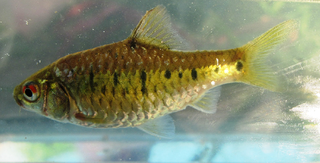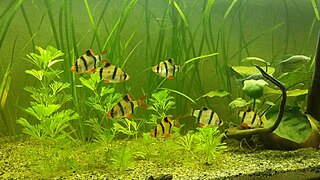
Cyprinidae is a family of freshwater fish commonly called the carp or minnow family, including the carps, the true minnows, and their relatives the barbs and barbels, among others. Cyprinidae is the largest and most diverse fish family, and the largest vertebrate animal family overall, with about 3,000 species; only 1,270 of these remain extant, divided into about 200 valid genera. Cyprinids range from about 12 mm (0.5 in) in size to the 3 m (9.8 ft) giant barb. By genus and species count, the family makes up more than two-thirds of the ostariophysian order Cypriniformes. The family name is derived from the Greek word kyprînos.

The tinfoil barb is a tropical Southeast Asian freshwater fish of the family Cyprinidae. This species was originally described as Barbus schwanenfeldii by Pieter Bleeker in 1853, and has also been placed in the genera Barbodes and Puntius. The specific epithet is frequently misspelled schwanefeldii.

Barbodes semifasciolatus, the Chinese barb, is a species of cyprinid fish native to the Red River basin in southeast Asia where they occur in fresh waters at depths of 5 metres (16 ft) or less. The captive variant popularly known as the gold barb or Schuberti barb is an extremely popular aquarium fish.

The rosy barb is a subtropical freshwater cyprinid fish found in southern Asia from Afghanistan to Bangladesh.

The tiger barb or Sumatra barb, is a species of tropical cyprinid fish. The natural geographic range reportedly extends throughout the Malay Peninsula, Sumatra and Borneo in Indonesia, with unsubstantiated sightings reported in Cambodia. Tiger barbs are also found in many other parts of Asia, and with little reliable collection data over long periods of time, definite conclusions about their natural geographic range versus established introductions are difficult. Tiger barbs may sometimes be confused with Puntigrus anchisporus, Puntigrus navjotsodhii, or Puntigrus partipentazona, which are similar in appearance, the only differences being the slightly different stripe pattern and the number of scales these fish have.

The checker barb is a species of cyprinid fish endemic to creeks, rivers, and lakes in Sumatra, Indonesia. It has also been established in the wild in Colombia. The adult males have red fins with black tips. It will grow up to a length of 5 centimetres (2.0 in) TL. This species is the only known member of its genus.

The black ruby barb or purplehead barb is a tropical cyprinid fish endemic to Sri Lanka, where it occurs in forested streams from the Kelani basin to the Nilwala basin. They are found in streams on hills around 1000 ft in elevation. The brightly colored population introduced to Mahaweli at Ginigathena, Sri Lanka, is said to have diminished in number due to the aquarium export trade.

The Denison barb, Denison's barb, Miss Kerala, red-line torpedo barb, or roseline shark is an endangered species of cyprinid fish endemic to the fast-flowing hill streams and rivers of the Western Ghats in India. It is commonly seen in the aquarium trade; pet collection caused it to become endangered and is its single major threat.

The golden barb or golden dwarf barb is a species of cyprinid fish native to inland waters in Asia, and is found in Pakistan, India, and Bangladesh. It has also been introduced to waters in Colombia. It natively inhabits rivers, and standing water with a silty bottom. They live in a tropical climate in water with a 6.0 - 6.5 pH, a water hardness of 8 - 15 dGH, and a temperature range of 68–77 °F (20–25 °C). It feeds on benthic and planktonic crustaceans, and insects. This species can grow in length up to 5.1 centimetres (2.0 in) TL. It can also be found in the aquarium trade.

The ticto barb or twospot barb is a species of subtropical freshwater fish belonging to the family Cyprinidae. It is a native of the upper Mekong, Salwen, Irrawaddy, Meklong and upper Charo Phraya basins in the countries of Nepal, India, Pakistan, Myanmar, Bangladesh, Thailand, and Sri Lanka. It has frequently been confused with the Odessa barb in the aquarium trade, but in that species the male is reddish-orange.

The Arulius barb is a tropical cyprinid fish native to the Kaveri River basin of south east India. Other common names include Tamiraparani barb, Silas barb and longfin barb.

Pethia stoliczkana is a fresh water tropical cyprinid fish native to the upper Mekong, Salwen, Irrawaddy, Meklong and upper Charo Phraya basins in the countries of Nepal, India, Pakistan, Myanmar, Bangladesh, Laos, Thailand, China and Sri Lanka.

Barbodes binotatus, commonly known as the spotted barb or common barb, is a tropical species of cyprinid fish endemic to Java, Indonesia.

The swamp barb, also known as chola barb, is a species of tropical freshwater fish belonging to the subfamily Cyprininae of the family Cyprinidae. It originates in inland waters in Asia, and is found in Pakistan, India, Nepal, Bangladesh, Sri Lanka, Bhutan, and Myanmar.

Barbodes lateristriga, the spanner barb or T-barb, is a species of cyprinid fish native to the Malay Peninsula and the island of Borneo. It can reach a length of 18 centimetres (7.1 in) TL. This species can also be found in the aquarium trade.

Puntigrus partipentazona, the Dwarf Tiger Barb, is a species of cyprinid fish native to Southeast Asia where it is found in the Mekong, Mae Klong, and Chao Phraya basins of Thailand, the Malay Peninsula, and coastal streams of southeast Thailand and Cambodia where it occurs in streams and impoundments with dense weed growth. It can also be found in the aquarium trade. It is frequently misidentified as the similar Puntigrus tetrazona.
Caecobarbus geertsi, the African blind barb or Congo blind barb, is a species of cyprinid fish. This threatened cavefish is only known from Democratic Republic of the Congo, and it is the only member of the monotypic genus Caecobarbus. George Albert Boulenger described this fish in 1921 and it apparently lacks any close relatives in the Congo region.

The Odessa barb is a species of cyprinid fish known from Central Myanmar, where it is known to occur in an artificial pond above the Anisakan Falls and also from the lower Chindwin River. For many years it has been known to the aquarium hobby, where it has frequently been confused with the less colourful ticto barb, but it was only described scientifically in 2008.
Pethia setnai is a species of cyprinid fish native to streams of the Western Ghats, India. It is an endemic fish and is most commonly found in flowing sections of hill streams and smaller rivers. It can reach a length of up to 5.7 centimetres (2.2 in) TL. The species named after later Dr. Sam Bomansha Setna, who was the first Director of Fisheries of the erstwhile Bombay State.

Haludaria is a genus of cyprinids native to freshwater habitats in the Western Ghats of India. Originally the genus was named DravidiaPethiyagoda, Meegaskumbura & Maduwage, 2012 which is preoccupied by the dipteran genus DravidiaLehrer, 2010.




















